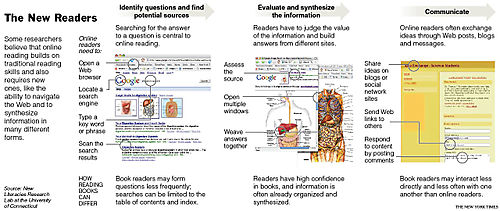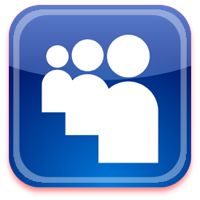The Digital Literacy Debate: Are We Really Reading on the Web?
As teenagers’ scores on standardized reading tests have declined or stagnated, some argue that the hours spent prowling the Internet are the enemy of reading — diminishing literacy, wrecking attention spans and destroying a precious common culture that exists only through the reading of books. … But others say the Internet has created a new kind of reading, one that schools and society should not discount. The Web inspires teenagers who might otherwise spend most of their leisure time watching television, to read and write. …Clearly, reading in print and on the Internet are different. On paper, text has a predetermined beginning, middle and end, where readers focus for a sustained period on one author’s vision. On the Internet, readers skate through cyberspace at will and, in effect, compose their own beginnings, middles and ends. More Literacy_Debate_Online,_RU_Really Reading? 120KB pdf
Is Google Making Us Stupid?
A recent article in the July/August 2008 issue of the Atlantic Monthly raises an interesting question for educators. Nicholas Carr asks Is Google Making Us Stupid? and he concludes that the internet may be changing the way we read and think. That shouldn’t come as a surprise to anyone who spends time around students. He writes,
I’m not thinking the way I used to think. I can feel it most strongly when I’m reading. Immersing myself in a book or a lengthy article used to be easy. My mind would get caught up in the narrative or the turns of the argument, and I’d spend hours strolling through long stretches of prose. That’s rarely the case anymore. Now my concentration often starts to drift after two or three pages. I get fidgety, lose the thread, begin looking for something else to do. I feel as if I’m always dragging my wayward brain back to the text. The deep reading that used to come naturally has become a struggle….For me, as for others, the Net is becoming a universal medium, the conduit for most of the information that flows through my eyes and ears and into my mind….And what the Net seems to be doing is chipping away my capacity for concentration and contemplation. My mind now expects to take in information the way the Net distributes it: in a swiftly moving stream of particles. Once I was a scuba diver in the sea of words. Now I zip along the surface like a guy on a Jet Ski.
Here’s the full article, if you have the attention span to finish it.
Question: How is Google Maps different from NCLB?
 Answer: It creates an environment to construct your own knowledge.
Answer: It creates an environment to construct your own knowledge.
Most have used one of the popular online map sites. What makes Google Maps different is it’s has left its source code open to encourage programmers to link to their data bases to develop their own web-based geographic information systems. The result is an explosion of interactive map sites – UK autumn colours, Indiana University housing, records of bird sightings in India, and New Orleans businesses that have reopened. They’re growing so quickly that there’s a site Google Maps Mania to help you keep up with all the new Google Map mashups. I used a free web-based service to do a Google Map of my recent clients.
Do I expect students to learn how to design Google Map-based program? No, but couldn’t students be given a chance to use information in more original and creative ways. The digital revolution has unleashed a flood of creativity with scores of new tools to copy, edit, alter, mix and redesign.
It’s too bad NCLB wasn’t based on a similar philosophy. Driven by growing accountability, students are rushed through an overcrowded curriculum with little time for reflection and few chances to create their own meaning. Last I checked “synthesis” was near the top of Bloom’s taxonomy.
“Too often school is the least engaging part of a student’s day”
That’s a pretty harsh assessment that comes from the recent report of the 21st Century Literacy Summit – A Global Imperative. It goes on to say,
“Students come to school equipped to learn on many levels … but today’s curricula do not meet their needs… Schools do their students a disservice when they fail to teach literacy in the expressive new language that their students have already begun to use before they even arrive.” Download report (808 kb) pdf
Loads of teachers are working hard to create classrooms where students can take on the challenge of intellectual work – rather than just look for the right answer. They want school to be more rigorous, relevant and engaging. Places that give students opportunities to learn how professionals approach their work – scientist, engineer, artist, historian, mathematician, writer, and musician.
But I couldn’t help but think that while teachers are fighting for market share of their students’ brains, Rupert Murdoch announced his purchase of MySpace.com. This two year-old site functions as a student lounge for an estimated 33 million young people. It has more page views than Google and is currently adding 4 million teens a month to its ranks of “addicts.” MySpace engages students because they are both the audience and the content providers. As one educator recently said to me, “my nephew loves MySpace. He posts his original music and artwork there and then uses the feedback from his viewers to improve his work.” All the strategies we’d love to use in our classrooms can potentially flourish there – cooperative learning, peer evaluation, differentiation, multiple learning styles, self-directed learning.
Students are used to controlling the flow of information in their lives. They can get what they want, when they want to – store it, catalogue it, alter it, and share it. What “market share” of student attention do our schools still retain? When students walked in the door this fall, did they feel more like they’re going back in time or into their futures?
We need to bring this movement into our schools rather than compete with it for the attention of our students. After all, I’ll bet our students are more concerned about their MySpace rankings than their school’s “adequate yearly progress” on state tests.




